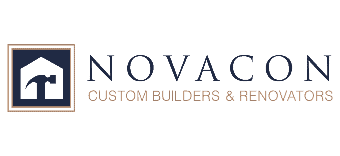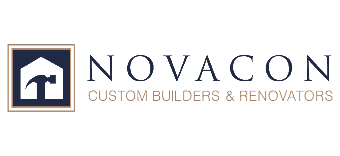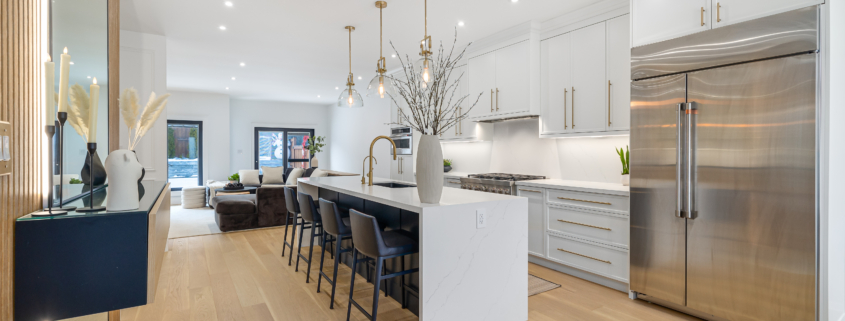Energy-Efficient Home Additions in Toronto: Building a Sustainable Future
Energy-efficient home additions are no longer just an environmental choice – they’re a smart financial investment that reduces utility costs while creating comfortable, healthy living spaces. In Toronto’s climate, where heating costs can account for 60% or more of annual energy bills, efficient design and construction techniques can dramatically reduce operating costs while improving year-round comfort.
The Greater Toronto Area is experiencing a significant shift toward sustainable building practices, driven by rising energy costs, environmental awareness, and government incentives promoting energy efficiency. Toronto homeowners are increasingly recognizing that energy-efficient additions not only reduce their carbon footprint but also provide superior comfort, lower maintenance costs, and higher resale values.
Modern energy-efficient technologies and building techniques make it possible to create additions that use 50-70% less energy than conventional construction while maintaining or improving comfort levels. From advanced insulation systems designed for Toronto’s extreme temperature variations to smart home technologies that optimize energy use automatically, today’s sustainable building options offer compelling benefits for both immediate comfort and long-term value.
Understanding Toronto’s Energy Efficiency Landscape
Climate Challenges and Opportunities
Toronto’s continental climate presents unique challenges and opportunities for energy-efficient design. With winter temperatures regularly dropping below -15°C and summer peaks exceeding 30°C, home addition contractors must design systems that perform efficiently across a 45-degree temperature range while managing significant seasonal humidity variations.
The city’s 4,500+ heating degree days annually make heating efficiency the primary concern for most additions. However, increasingly hot summers and growing air conditioning use mean cooling efficiency is becoming equally important. Energy-efficient additions must address both heating and cooling loads while managing the transition periods when neither heating nor cooling is required.
Toronto’s relatively short construction season also influences energy-efficient design strategies. Home addition contractors experienced in local conditions understand how to design and build efficiently during favorable weather while planning interior work and system installations for winter months when exterior construction becomes challenging.
Growing Sustainability Trends
The trend toward energy-efficient additions in Toronto reflects broader environmental awareness and economic pressures facing homeowners. Rising utility costs, increasingly frequent extreme weather events, and growing understanding of buildings’ environmental impact are driving demand for sustainable construction practices.
Toronto’s Green Standard program encourages energy-efficient construction through expedited permit processes and development incentives. While primarily focused on new construction and large developments, these standards influence residential addition design and demonstrate the city’s commitment to sustainable building practices.
Local utility programs like Toronto Hydro’s energy efficiency incentives and Enbridge’s rebates for high-efficiency heating systems make energy-efficient additions more financially attractive. These programs often provide substantial rebates for efficient windows, insulation upgrades, and high-performance heating and cooling systems.
Building Code Evolution
Ontario’s building code increasingly emphasizes energy efficiency, with recent updates requiring higher insulation levels, improved air sealing, and more efficient mechanical systems. These code changes establish minimum standards that experienced home addition contractors often exceed to provide superior performance and future-proof their clients’ investments.
The National Energy Code requirements influence addition design by establishing standards for thermal performance, air leakage, and equipment efficiency. Understanding these evolving standards helps homeowners make informed decisions about energy-efficient features that will remain relevant as codes continue to advance.
Energy modeling requirements for larger additions provide detailed analysis of energy performance, helping homeowners understand the financial and environmental benefits of various efficiency measures. This modeling also identifies the most cost-effective improvements for specific projects and climate conditions.
High-Performance Building Envelope Design
Advanced Insulation Strategies
The building envelope represents the first line of defense against Toronto’s extreme temperatures, making insulation selection and installation crucial for energy-efficient additions. Modern insulation technologies far exceed traditional fiberglass batts in performance, with options like spray foam, rigid foam boards, and mineral wool providing superior thermal resistance and air sealing capabilities.
Continuous insulation strategies eliminate thermal bridging through framing members, which can reduce insulation effectiveness by 20-30% in traditional construction. Home addition contractors experienced in energy-efficient design use techniques like exterior rigid foam, advanced framing methods, or structural insulated panels to maintain consistent thermal barriers.
Proper vapor barrier and air sealing installation becomes critical in Toronto’s climate where significant temperature differences between indoor and outdoor conditions create strong driving forces for air and moisture movement. Quality installation prevents drafts, reduces energy loss, and prevents moisture problems that can damage building materials and create health issues.
High-Performance Windows and Doors
Windows and doors represent significant opportunities for energy savings in Toronto additions, where heating season extends from October through April. Triple-glazed windows with low-E coatings and gas fills can achieve R-values of 7-10, compared to R-3 for standard double-glazed units, dramatically reducing heat loss during cold weather.
Proper window selection balances thermal performance with solar gain opportunities. South-facing windows can capture valuable solar energy during Toronto’s sunny winter days, while high-performance glazing prevents excessive heat gain during summer months. Energy-efficient window selection considers both seasonal performance and long-term durability in Toronto’s harsh climate.
Installation quality is as important as window performance, with poor installation negating the benefits of high-performance units. Experienced contractors understand proper flashing, air sealing, and thermal bridge management around window and door openings to maintain the building envelope’s integrity.
Air Sealing and Ventilation Balance
Creating an airtight building envelope must be balanced with controlled ventilation to maintain healthy indoor air quality. Energy-efficient additions typically achieve air leakage rates of 1.5 air changes per hour or less at 50 Pascals pressure, compared to 4-6 ACH50 for conventional construction.
Heat recovery ventilators (HRVs) are particularly effective in Toronto’s climate, capturing 70-85% of heat from outgoing stale air to warm incoming fresh air. This technology provides necessary ventilation while minimizing energy loss, maintaining comfort and air quality throughout Toronto’s long heating season.
Proper HRV sizing and installation requires understanding of the addition’s specific ventilation needs, integration with existing home systems, and consideration of Toronto’s air quality conditions. Professional design ensures optimal performance while avoiding over-ventilation that wastes energy or under-ventilation that compromises air quality.
Energy-Efficient Mechanical Systems
High-Efficiency Heating Solutions
Heating system selection significantly impacts energy costs and comfort in Toronto additions. Modern high-efficiency furnaces achieve Annual Fuel Utilization Efficiency (AFUE) ratings of 95% or higher, compared to 80-85% for standard units, translating to substantial energy savings over the system’s 15-20 year lifespan.
Heat pump technology designed for cold climates offers excellent efficiency for Toronto additions. Cold climate heat pumps maintain efficiency at temperatures as low as -25°C, providing both heating and cooling while using 50-70% less energy than traditional heating systems. Ground-source heat pumps achieve even higher efficiency by utilizing stable underground temperatures.
Radiant floor heating systems offer exceptional comfort and efficiency when properly designed for Toronto’s climate. These systems operate at lower temperatures than forced-air systems, thereby reducing energy consumption while providing even, comfortable heat distribution. Integration with high-efficiency boilers or heat pumps further maximizes both comfort and efficiency.
Smart Climate Control Systems
Smart thermostats and zoning systems optimize energy use by heating and cooling only occupied spaces when needed. These systems learn usage patterns and adjust temperatures automatically, providing comfort when needed while reducing energy waste during unoccupied periods.
Zoning capabilities become particularly valuable in additions where different spaces have varying usage patterns and comfort requirements. Home offices might need consistent temperatures during work hours, while guest rooms can operate at reduced temperatures when unoccupied.
Integration with smart home systems enables advanced energy management strategies like demand response participation, utility rate optimization, and coordination with renewable energy systems. These capabilities provide immediate energy savings while positioning the addition for future energy management opportunities.
Efficient Domestic Hot Water Systems
Hot water heating accounts for 15-20% of typical home energy use, making efficient systems important components of energy-efficient additions. High-efficiency condensing water heaters achieve efficiency ratings above 90%, while heat pump water heaters can achieve equivalent efficiency ratings of 200-300%.
Integration with space heating systems through combination boilers or indirect water heaters can provide space and efficiency advantages in additions. These systems eliminate the need for separate water heating equipment while providing excellent efficiency and reliability.
Solar water heating systems work well in Toronto’s climate, providing 40-60% of annual hot water needs through solar collection. While initial costs are higher, federal and provincial incentives combined with energy savings often provide attractive returns on investment for homeowners committed to renewable energy.
Smart Technology Integration
Home Automation for Energy Management
Smart home technology enables sophisticated energy management strategies that automatically optimize comfort and efficiency based on occupancy, weather conditions, and utility rates. These systems learn from usage patterns and adjust automatically, providing convenience while reducing energy consumption.
Energy monitoring systems provide real-time feedback on energy use, helping homeowners understand consumption patterns and identify opportunities for additional savings. Detailed monitoring can reveal inefficient appliances, poor system performance, or behavioral patterns that increase energy use unnecessarily.
Integration with utility demand response programs allows automated participation in grid stabilization efforts while providing financial incentives for reducing peak-time energy use. These programs are becoming increasingly common in Toronto as utilities work to manage peak demand and integrate renewable energy sources.
Renewable Energy Integration
Solar panel installations on addition roofs can offset significant portions of energy use while taking advantage of available incentives and net metering programs. Toronto’s solar potential, while not exceptional, still provides worthwhile returns when combined with high-efficiency design that minimizes total energy needs.
Battery storage systems paired with solar installations provide backup power capabilities while enabling more sophisticated energy management strategies. These systems can store excess solar production for use during peak rate periods or power outages, providing both financial and resilience benefits.
Electric vehicle charging preparation is becoming standard in energy-efficient additions as more Toronto families adopt electric vehicles. Pre-wiring for Level 2 charging stations provides convenience while avoiding costly retrofits when EVs are purchased later.
Advanced Building Controls
Building automation systems can coordinate heating, cooling, ventilation, and lighting systems for optimal efficiency while maintaining comfort. These systems consider factors like outdoor temperature, solar conditions, occupancy patterns, and utility rates to minimize energy use automatically.
Lighting controls including occupancy sensors, daylight dimming, and programmable scheduling can reduce lighting energy use by 30-50% while improving convenience and security. LED lighting combined with smart controls provides excellent efficiency and long service life.
Water management systems including leak detection, usage monitoring, and efficient fixture controls contribute to overall sustainability while protecting against water damage. These systems are particularly valuable in additions where new plumbing systems are being installed.
Financial Benefits and Return on Investment
Immediate Cost Savings
Energy-efficient additions typically reduce utility bills by 30-50% compared to conventional construction, providing immediate financial benefits that help offset higher initial construction costs. In Toronto’s climate, these savings are particularly significant during heating season when efficient design can reduce natural gas consumption substantially.
The combination of reduced energy use and available utility rebates often provides payback periods of 3-7 years for energy-efficient features, making them excellent financial investments independent of environmental benefits. Longer-term equipment life and reduced maintenance costs further improve financial returns.
Peak demand reduction through efficient design and smart controls can provide additional savings through utility demand charges and time-of-use rate optimization. These savings become increasingly valuable as utility rate structures evolve to reflect grid management needs.
Long-Term Value Creation
Energy-efficient additions typically command premium resale values, with efficient homes selling faster and for higher prices than comparable conventional properties. Toronto’s competitive real estate market increasingly values energy efficiency as buyers become more aware of operating costs and environmental impact.
Future-proofing benefits include protection against rising energy costs, compliance with evolving building codes, and compatibility with emerging technologies like smart grids and electric vehicle integration. These benefits provide value insurance against uncertain future energy markets and regulatory changes.
Reduced maintenance requirements for high-quality, energy-efficient systems provide ongoing financial benefits through lower repair costs and longer equipment life. Quality insulation, efficient windows, and proper air sealing also protect building materials from moisture damage and thermal stress.
Available Incentives and Programs
Federal and provincial rebate programs provide substantial financial incentives for energy-efficient additions, with programs like Canada Greener Homes offering rebates up to $5,000 for qualifying improvements. These programs often provide additional incentives for comprehensive energy efficiency improvements.
Utility programs through Toronto Hydro and Enbridge provide rebates for efficient equipment, insulation upgrades, and smart home technologies. These programs change periodically but consistently provide financial incentives for energy-efficient construction and equipment.
Property tax considerations may include reduced assessments for energy-efficient improvements or special financing programs for sustainable construction. While not universal, these programs provide additional financial incentives for energy-efficient additions in some GTA municipalities.
Building an energy-efficient addition in Toronto requires balancing upfront investment with long-term benefits while navigating the technical complexities of high-performance construction. The key is working with experienced professionals who understand both energy-efficient design principles and Toronto’s specific climate challenges and building requirements.
The growing trend toward energy-efficient construction reflects both environmental responsibility and smart financial planning. As energy costs continue rising and building codes become more stringent, energy-efficient additions provide future-proof value that benefits both homeowners and the broader community.
Ready to explore energy-efficient options for your Toronto home addition? Novacon Construction is an award-winning design-build contractor with extensive experience in creating custom home additions that combine superior energy efficiency with exceptional comfort and quality. Our expertise in high-performance building techniques and deep understanding of Toronto’s climate ensure your addition will provide lasting value through reduced energy costs and enhanced livability.
- When to Start Planning Your Home Addition in Toronto - December 3, 2025
- How Many Dwellings Can I Build On a Single Lot in Ontario? - October 29, 2025
- Home Renovation and Additions in Toronto: Combining Upgrades for Maximum Impact - October 29, 2025







